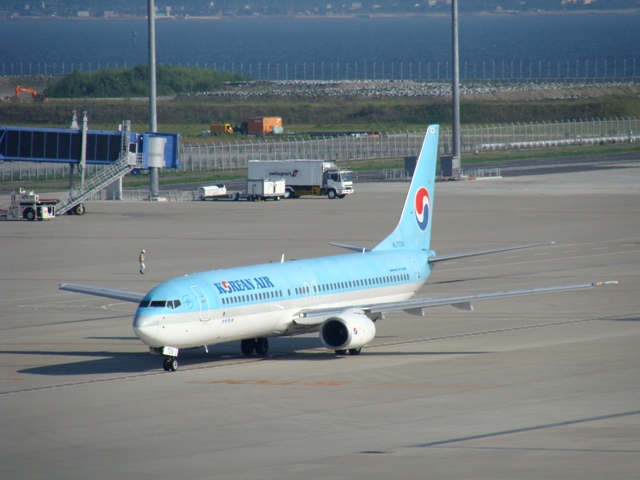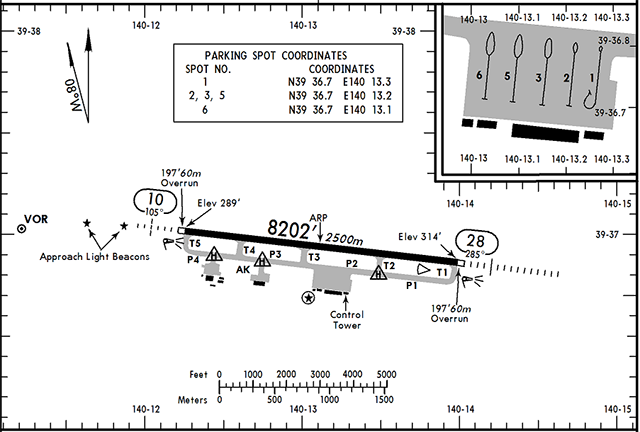The long history of accidents involving the Airlines of Korea suggests their pilots are uncomfortable visually maneuvering for landing. This mishap was flown on a state-of-the-art Boeing 737 using a HUD to line up on a taxiway mistaken for a runway. Both pilots failed to understand the VOR approach they were flying did not end at the runway threshold and failed to transition to visual procedures, though the weather was good.
— James Albright

Updated:
2013-07-27
They were lucky the taxiway was not occupied by other aircraft.
Note: I don't have any primary source material on this accident, though the conclusions seem self evident.

1
Accident report
- Date: 06 JAN 2007
- Time:
- Type: Boeing 737-900
- Operator: Korean Air
- Crew: Fatalities: 0 / Occupants: 9
- Passengers: Fatalities: 0 / Occupants: 124
- Total: Fatalities: 228 / Occupants: 133
- Airplane fate: No damage
- Location: Akita Airport, Akita, Japan
- Phase: Landing (LND)
- Nature: International Scheduled Passenger
- Departure airport: Incheon International Airport, Seoul, South Korea
- Destination airport: Akita Airport, Akita, Japan (RJSK/AXT)
2
Narrative
On 6 January 2007, a Boeing B737-900 operated by Korean Airlines landed at Akita Airport on a taxiway parallel to the in-use runway after a daylight non-precision approach (NPA) using a head-up display (HUD). The crew realized their error during the landing roll. Though there was light rain, the visibility was 10 km.
4
Cause
The Japanese Aircraft and Railway Accidents Investigation Commission noted the following:
- "[…] according to the conversation […] recorded by the CVR, it is estimated that the captain mistook the taxiway for the runway. And he said, “I’ll make a landing there” at 14m52s. It is estimated that the first officer also agreed with the captain in the course of the conversation.
- […] because the first officer said, “It looked like as though there were two runways”, it is considered that the captain saw the runway likewise. It is considered that their failure to distinguish the runway from the narrower taxiway, which is located on the right-hand side of the runway, was caused by such reasons that the captain and the first officer forgot and did not reconfirm the relative locations of the runway and the taxiway, that visibility was poor due to rain, that they saw the runway in the distance when the Aircraft was heading rightward in the strong crosswind and its flight path was nearly aligned with the taxiway, and that it was difficult to see boundary of the rain-wet taxiway.
- Under such circumstance, because the captain mistakenly assumed that the VOR approach course was heading toward the runway, and the FDGC [Flight Director Guidance Cue], LNAV [Lateral Navigation], and the like indicate direction to the runway, it is considered that he mistook the right side taxiway for the runway, assuming that the one corresponding to the flight path was the runway. Meanwhile, it is considered that although the first officer at first correctly recognized the runway based on the position of PAPI, he misunderstood that the LNAV course were leading to the runway, and agreed with the captain. Furthermore, concerning that the captain and the first officer mistakenly interpreted the indication of the instruments, it is considered contributory that they did not know that VOR No.1 approach course ran in parallel with the runway, and that its extended line was nearly superposed on the taxiway.
- Because the captain continued an approach relying on HUD and ND indications when he should have made a visual approach after he got the runway in sight, it is considered that his attention to the outside view was diminished, and thereby he was unable to correct his mistake.
- Even under the visual meteorological conditions, if there was any uncertainty about visual identification of the runway, the captain should have taken such measures to ensure correct identification of the runway as requesting the lighting of the runway lights or confirming the aerodrome chart, but it is considered that he did not consider it necessary to use various confirmation measures due to his misunderstanding that the indication of the instruments points to the runway."

